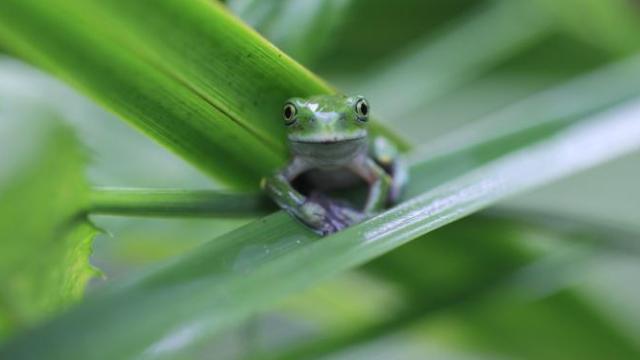For twenty years, the deadly fungal disease Bd has been wiping out amphibians across the world. But a new study offers hope that some frogs will be spared, thanks in part to an unexpected saviour: climate change.
It’s not often that we hear about positive impacts of anthropogenic climate change. And yet, a team of scientists at the Wildlife Conservation Society is now predicting that in Africa’s Albertine Rift — one of the most biodiverse places on the planet — global warming will cause Bd‘s range to contract, which could stave off spread of the awful disease.
“Bd prevalence in the Albertine Rift may decrease as a result of climate change,” lead study author Tracie Seimon said in a statement. “This is borne out by the modelling we have presented, which indicates a major range contraction of habitat suitability for this fungus by the end of the century.”
Bd, short for Batrachochytrium dendrobatidis, is an amphibian skin disease caused by the fungus chytridiomycosis. Nobody’s certain where it originated, but over the past few decades, the fungus has hitched a ride around the world on muddy shoes and in suitcases, by air and by sea. And everywhere it travels, it kills frogs with brutal efficiency. To date, Bd has been blamed for at least 200 population crashes or extinctions on five continents. The situation is so dire that some scientists call Bd “the worst infectious disease ever recorded among vertebrates”.
Only in the past year have we heard heard hints that the fight against Bd might not be hopeless. Two months ago, a team of biologists announced that they’d eliminated the disease from five ponds on the Spanish island of Majorca — the first time anyone has ever managed to clear an infected habitat. But the process was intense. The scientists had to remove and treat each frog individually, drain the ponds, blast the ground with fungicide, refill the ponds with clean water and finally reintroduce the animals.
Will it take a worldwide wetland blitzkrieg to save frogs from mass extinction? Maybe not, if the new study’s optimistic outlook holds up. The researchers’ climate models predict that Bd‘s range will contract significantly over the 21st century, as the Albertine Rift, home to over 145 amphibian species, gets warmer and wetter.
While this may offer struggling frogs some much-needed relief, the authors say we should take the findings with caution. After all, global warming could have many unforeseen impacts.
“There are many variables to consider when trying to understand if frogs can or currently are adapting to climate change,” Seimon told Gizmodo in an email, noting that changes in food and water resources, predation, disease, and other environmental factors all need to be considered. “Long-term monitoring in the Albertine Rift region is needed to better understand these complexities.”
Another encouraging sign comes from the research team’s genetic analysis of 17 amphibian genera from 39 sites in the Albertine Rift. While about 20 per cent of frogs sampled over a five year period tested positive for Bd, “the vast majority of infected frogs appeared healthy and did not have clinical symptoms of the disease,” Siemon said.
In other words, many of the frogs in this region could already be resistant. Which sort of makes sense, when you consider the fact that there’s evidence for Bd in Africa dating all the way back to the 1930s. “Research supports the hypothesis that chytrid has been in Africa a very long time, and could explain why so many African species do not appear to get sick,” Seimon noted.
Bd remains a huge threat to thousands of amphibian species worldwide. But it’s very encouraging to hear that in one corner of our planet, at least, frogs seem to be putting up a good fight.
[PLOS One]
Top: A frog from the Leptopelis family photographed in Bwindi Impenetrable National Park, Uganda, via Tracie Seimon/WCS
